Symmetries - The Nucleus as a Laboratory
| transformation name |
operation |
consequence |
| translation |
transport coordinate system by a displacement
vector |
linear momentum is conserved if no forces are present |
| rotation |
rotate coordinate system about a given axis |
conservation of angular momentum if force is direction
independent |
| time |
translation along time axis |
conservation of mechanical energy if force can be
expressed as the gradient of a potential |
| reflection or LH<->RH coordinate system |
make a reflection of axes or equivalently go from
a left handed to a right handed coordinate system |
conservation of parity if the results of experiments
can be equally well described using a LH or RH coordinate system |
| charge conjugation |
convert all particles into anti particles |
matter and anti matter equivalence |
PARITY AND CHARGE CONJUGATION
BETA DECAY OF Cobalt-60
Cobalt-60 -> Zinc-60 + electron + anti-neutrino
| Beta decay of cobalt-60 as seen in a right handed
coordinate system.
In the diagram on the right a current, I, is driven
through a coil to produce a magnetic field B. The electrons which cause
the current are indicated as small blue spheres which travel in the opposite
direction to the conventional current I. This current I produces a magnetic
field B which, by the right hand rule is pointing up. The cobalt-60 nucleus
is positively charged. We can imagine it to be spinning in the direction
as indicated. The classically spinning charged sphere has a magnetic moment
given by the right hand rule. The nucleus behaves similarly. The magnetic
moment of the nucleus points along the spin direction S. The torque exerted
by B on the tiny nuclear magnet causes S to line up with B. |
 |
What happens when we make the observation of beta decay
from the left handed coordinate system? Lee and Yang,
1956, suggested that beta decay may not exhibit reflection symmetry.
| In the experiment of C.
S. Wu et al, 1957, cobalt-60 nuclei were cooled to very low temperatures,
about 0.01K, and their magnetiv moments S were aligned by imposing an external
magnetic field B produced by current I in a coil. In the right handed coordinate
system (rh) the observation is that electrons (blue circles) are preferentially
emitted in a direction opposite the magnetic moment S in a ratio about
150/100. In the left handed coordinate system the observation is that electrons
are preferentially emitted in the same direction as S. The observations
about the nature of the beta decay process then depends on which coordinate
system is used. This results shows that there is no "reflection" symmetry
for the weak force that causes beta decay. Another way of saying this is
that " parity" is not conserved in beta decay. |
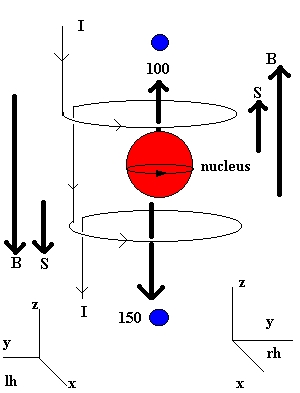 |
| What happens if we transform all particles into their
anti particles. This is called the "Charge Conjugation" transformation.
The electrons that are moving through the wires to
produce the current I now become positrons, ( the anti - electron). The
current I then points in the direction shown. This produces a magnetic
field B by the right hand rule, pointing down. The nucleus becomes anti-cobalt60.
It is now a negatively charged rotating sphere. Using the right hand rule
to obtain the spin direction and noting that the negatively charged rotating
body has a magnetic moment opposite to its angular momentum, the magnetic
moment S still points along B. Our anti-universe observer concludes that
the charged leptons( positrons) are preferentially emitted in the direction
of S. This again is different from the observation in the matter universe. |
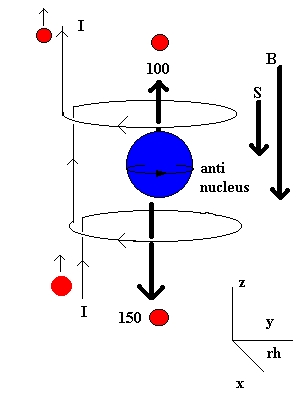 |
From this experiment we see that
beta decay violates reflection symmetry and matter/antimatter symmetry.
| What would happen if our anti-matter observer used
a left handed coordinate system? In this case B would point up by the left
hand rule. The magnetic moment of the anti-cobalt60 nucleus also points
up because of the negatively charged nucleus. This observer would conclude
that the charged leptons(positrons) are preferentially emitted in the direction
opposite the magnetic moment of the nucleus. Hence, his observation is
the same as that of the righthanded observer in the matter universe. From
these results we conclude that the weak force responsible for beta decay
is symmetric under the combined transformations of reflection (parity,
P) and charge conjugation(C), or we say the beta decay is CP invariant.
While this appears to be true for beta decay we must note that there is
a small but significant violation of CP invariance for the weak decay of
the neutral kaon. |
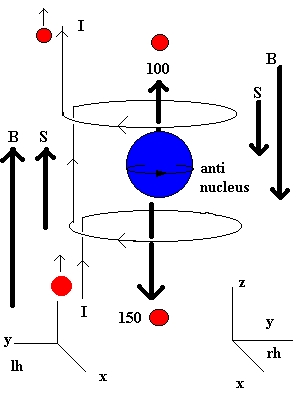 |
| Suppose we we run time backwards after we have changed
to a LH coordinate system and done the charge conjugation. The directions
of all velocities must change. Then the residual nucleus, zinc-60, becomes
a target which preferentially absorbs electrons coming against the magnetic
moment. The combined transformation PCT yields the same conclusion as the
original panel at the top. The beta decay process produces an asymmetric
emission/absorption of electrons. Electrons are preferentially emitted/absorbed
when they travel in a direction opposite to the magnetic moment of the
decaying/absorbing nucleus. |
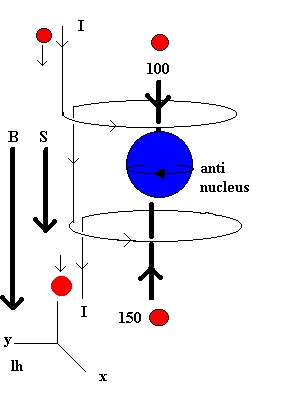 |
| Very general arguments require that the combined transformations
of reflection and charge conjugation and time reversal, PCT, must be a
symmetry for all physical forces! |
Direct observation of neutrinos from beta decay was
made by Reines et al. in 1953

 |
Neutrons can decay in free space and inside nuclei
into protons and electrons and anti neutrinos. It has been discovered that
the anti neutrinos emitted in beta decay have their spin vectors pointing
in the direction of their momentum. We call the anti neutrinos from beta
decay "right-handed" because their spin direction can be define to be along
the momentum direction if a right hand rule is use to define spin dirction. |
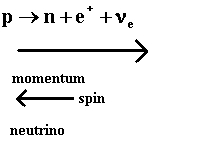 |
Protons inside a nucleus can decay into a neutron,
a positron, and a neutrino. Neutrinos emitted in positron decay have their
spin vectors pointed oppositely to their momentum vectors. We call the
neutrinos from beta decay "left-handed" because their spin direction can
be defined to be in same same direction as their momentum if a left hand
rule is used to define spin direction. |
We note that anti neutrinos with their spin anti parallel
to momentum have never been seen. Neutrinos with their spin parallel to
their momentum have also never been seen.
The Modern theory of the weak interactions was developed
by Weinberg, Glashow, and Salam. This theory unites
the electromagnetic force and the weak force.
Internal Symmetries